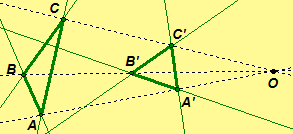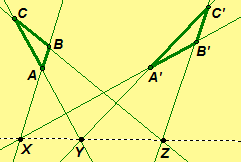4.2.1
Axioms and Basic Definitions for Plane Projective Geometry
![]() Printout
Printout
Teachers open the door, but you must enter by
yourself.
—Chinese Proverb
Undefined Terms. point, line, incident
Axiom 1. Any two distinct points are incident with exactly one line.
Axiom 2. Any two distinct lines are incident with at least one point.
Axiom 3. There exist at least four points, no three of which are collinear.
Axiom 4. The three diagonal points of a complete quadrangle are never collinear.
Axiom 5. (Desargues' Theorem) If two triangles are perspective from a point, then they are perspective from a line.
Axiom 6. If a projectivity on a pencil of points leaves three distinct points of the pencil invariant, it leaves every point of the pencil invariant.
Basic Notation.
- Points are denoted by upper case letters and lines by lower case letters.
- Denote the line determined by two distinct points A and B by AB.
- Denote a point determined by two distinct lines a and b by a · b. Note that this refers to the point of intersection of two lines, not the set of points of intersection, i.e. a ∩ b = {a · b}.
- A set of points is collinear if every point in the set is
incident with the same line.
Points incident with the same line are said to be collinear.
- Lines incident with the same
point are said to be concurrent.
- A complete quadrangle is a set of four points, no three
of which are collinear, and the six lines incident with each pair of these
points. The four points are called vertices
and the six lines are called sides
of the quadrangle.
Example: Complete quadrangle ABCD has vertices A, B, C, and D. The sides are AB, AC, AD, BC, BD, and CD.
- Two sides of a complete
quadrangle are opposite if the
point incident to both lines is not a vertex.
Example: Complete quadrangle ABCD has three pairs of opposite sides AB and CD, AC and BD, and AD and BC.
- A diagonal point of a complete quadrangle is a point
incident with opposite sides of the quadrangle.
 Model. The vertices of the quadrangle ABCD are A, B, C and
D. The sides of the quadrangle are AB, AC, AD, BC, BD, and CD.
The opposite sides are AB and CD, AC and BD, and AD
and BC. The diagonal points of the quadrilateral are E, F and
G.
Model. The vertices of the quadrangle ABCD are A, B, C and
D. The sides of the quadrangle are AB, AC, AD, BC, BD, and CD.
The opposite sides are AB and CD, AC and BD, and AD
and BC. The diagonal points of the quadrilateral are E, F and
G.
Click here to go to a
dynamic
illustration of a quadrangle
GeoGebra or
JavaSketchpad.
- A triangle is a set of three noncollinear points and the
three lines incident with each pair of these points. The points are called
vertices, and the lines are called sides.
Cautionary Note. A triangle in a projective geometry is different from a triangle in Euclidean geometry. Each side of a triangle in projective geometry is a line, whereas each side of a triangle in Euclidean geometry is a segment. Betweenness of points in projective geometry is not defined; therefore, projective geometry does not have segments defined. In spite of this, we will often use Euclidean triangles in illustrations.
- Two figures are perspective from a point provided the lines determined from corresponding points are concurrent. The point is called the center.
- Two figures are perspective
from a line provided the points of intersection of corresponding
sides are collinear. The line is called the axis.
Examples: The left-hand figure illustrates triangles perspective from a point. (The lines AA', BB', and CC' are concurrent through O.) The right-hand figure illustrates triangles perspective from a line. (The lines AB and A'B' intersect at X, AC and A'C' intersect at Y, and BC and B'C' intersect at Z; further, X, Y, and Z are collinear.)


Click here for a
dynamic
illustration of perspective from a point and perspective from a line
GeoGebra or JavaSketchpad.
- A set of points incident
with a line is called a pencil of points (or range of points), and the line is
called the axis. A set of lines
incident with a point is called a pencil of
lines, and the point is called the center.
Example: A set of points {A, B, C, D} on a line l is called a pencil of points with axis l. A set of lines {a, b, c, d} concurrent at a point P is called a pencil of lines with center P.
- A
one-to-one mapping between two pencils of points is called a
perspectivity
if the lines incident with the corresponding points of the two pencils are
concurrent. The point where the lines intersect is called the center of the perspectivity. A
perspectivity is denoted
where O is the center of perspectivity.
- A
one-to-one mapping between two pencils of points is called a
projectivity
if the mapping is a composition of finitely many perspectivities. A
projectivity is denoted
.
Examples: The left-hand figure is a perspectivity between two pencils of points with axes p and p',, and the right-hand figure is a projectivity,
, consisting of the product of two perspectivities,
and
Click here for a dynamic illustration of the perspectivity and projectivity. GeoGebra or JavaSketchpad.

